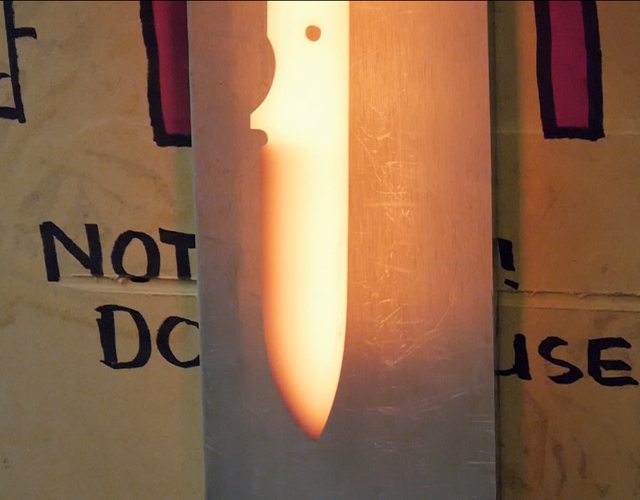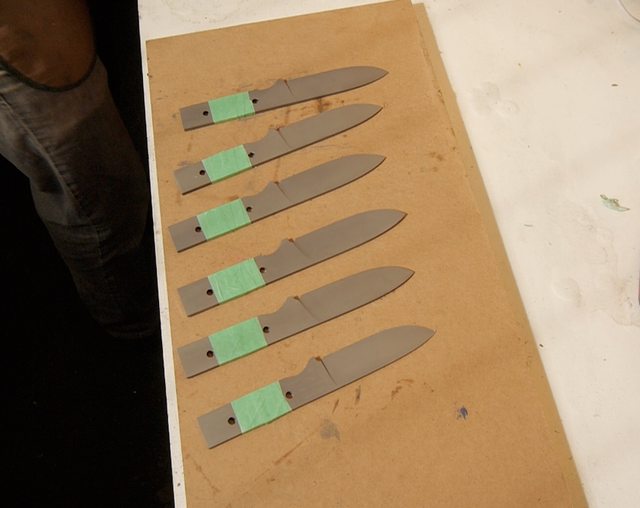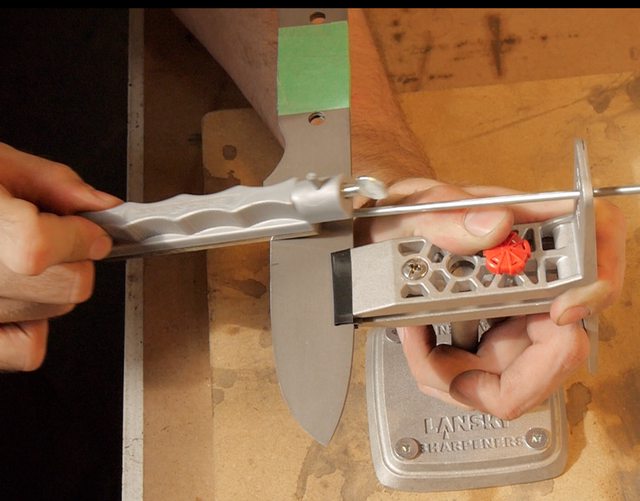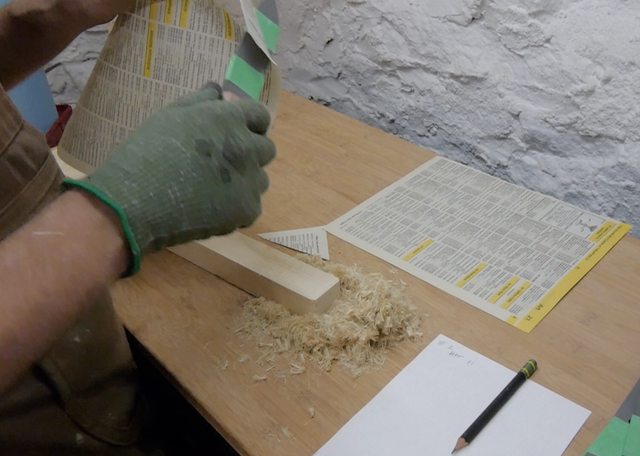- Joined
- Mar 12, 2013
- Messages
- 1,167
Hey guys!
First post here, but I've posted a reasonable amount to other forums in the past. I'm posting here now because I'm doing some testing on a variety of steels that other people may find informative. Some examples of my past work (just to show I'm not a complete newb ):
):
http://imgur.com/a/rXsQC
http://imgur.com/a/dNdyB
http://imgur.com/a/bM6Hj
Now, before I start let me just disclaim something: These tests are in no way the last word on these steels!
My sample sizes are too small, and my tests far too subjective for these tests to be authoritative. They're meant to give me a feel for each steel, and to be a good introduction for me to each one. This thread is not meant to start any steel holy wars. If anything I'm putting this stuff out there so that I can learn more from all you experienced folks!
-------
In the past my knives have been made from O1 that was heat-treated in a small 2 brick forge. I was overall happy with the results but found that I was getting a bit too much edge-rolling with the O1. I figured this was likely because of my heat-treat so I bought a kiln. Once I bought the kiln I realized that there was a whole world of steel out there, and that it was likely something else was better suited to my style of knives!
In order to decide which steel I wanted to use going forward I decided to make a variety of test blades in different steels and then put them through their paces.
The steels I'm testing are:
The test blades were ground from their respective stock, heat-treated, and then sand-blasted so that they would be as identical as possible. As I did each one I engraved the name of the steel in the handle area of the test blade. The heat treatment recipes were basically whatever the manufacturer recommended:
CPM3V
Preheat to 1500ºF, Equalize
Ramp to 2050ºF, hold for 20 minutes
Quench in air to below 125ºF
Temper at 1000ºF, 3 times, 2 hours each
Aim hardness 61HRC
440C
Preheat to 1425ºF, equalize
Ramp to 1900ºF, hold for 20 minutes
Quench in air to room temperature
Temper at 300ºF, 2 times, 2 hours each
Aim hardness 59HRC
CPM154
Preheat to 1400ºF, equalize
Ramp to 1900ºF, hold for 60 minutes
Quench in oil to below 125ºF
Cryo-quench into dry-ice & isopropanol for 20 minutes
Temper at 400ºF, 2 times, 2 hours each
Aim hardness 60HRC
O1
Preheat to 1250ºF, equalize
Ramp to 1500ºF, hold for 15 minutes
Quench in oil to 150ºF
Temper at 400ºF, 2 hours
Cryo-quench into dry-ice & isopropanol for 20 minutes
Temper at 400ºF, 2 hours
Aim hardness 61HRC
A2
Preheat to 1100ºF, equalize
Ramp to 1775ºF, hold for 35 minutes
Quench in air to below 150ºF
Temper at 400ºF, 2 hours
Cryo-quench into dry-ice & isopropanol for 20 minutes
Temper at 400ºF, 2 hours
Aim hardness 61HRC
The O1 that received the 'homebrew' heat-treat was basically heated in a propane fired forge until dull cherry red, then quenched in oil. It was then tempered twice at 400ºF, two hours each time.

CPM-3V moments after leaving the kiln
After all the blades were finished the next step was to ensure that the edge thickness of each blank was as identical as possible. The edge thickness I was aiming for was 0.013". All the blanks ended up being a maximum of 0.0005" away from this thickness. This was achieved by grinding each blade a little thin, then using a diamond hone along the edge of the blank until the edge was the correct thickness.
** Be aware that my test blades are a little sloppy around the plunges and such. I only just got a grinder and these are the first knives I've made using a grinder rather than filing by hand.
First post here, but I've posted a reasonable amount to other forums in the past. I'm posting here now because I'm doing some testing on a variety of steels that other people may find informative. Some examples of my past work (just to show I'm not a complete newb
http://imgur.com/a/rXsQC
http://imgur.com/a/dNdyB
http://imgur.com/a/bM6Hj
Now, before I start let me just disclaim something: These tests are in no way the last word on these steels!
My sample sizes are too small, and my tests far too subjective for these tests to be authoritative. They're meant to give me a feel for each steel, and to be a good introduction for me to each one. This thread is not meant to start any steel holy wars. If anything I'm putting this stuff out there so that I can learn more from all you experienced folks!
-------
In the past my knives have been made from O1 that was heat-treated in a small 2 brick forge. I was overall happy with the results but found that I was getting a bit too much edge-rolling with the O1. I figured this was likely because of my heat-treat so I bought a kiln. Once I bought the kiln I realized that there was a whole world of steel out there, and that it was likely something else was better suited to my style of knives!
In order to decide which steel I wanted to use going forward I decided to make a variety of test blades in different steels and then put them through their paces.
The steels I'm testing are:
- O1 (homebrew heat-treat in small forge, for reference to my past knives)
- O1
- A2
- CPM154
- CPM3V
- 440C
The test blades were ground from their respective stock, heat-treated, and then sand-blasted so that they would be as identical as possible. As I did each one I engraved the name of the steel in the handle area of the test blade. The heat treatment recipes were basically whatever the manufacturer recommended:
CPM3V
Preheat to 1500ºF, Equalize
Ramp to 2050ºF, hold for 20 minutes
Quench in air to below 125ºF
Temper at 1000ºF, 3 times, 2 hours each
Aim hardness 61HRC
440C
Preheat to 1425ºF, equalize
Ramp to 1900ºF, hold for 20 minutes
Quench in air to room temperature
Temper at 300ºF, 2 times, 2 hours each
Aim hardness 59HRC
CPM154
Preheat to 1400ºF, equalize
Ramp to 1900ºF, hold for 60 minutes
Quench in oil to below 125ºF
Cryo-quench into dry-ice & isopropanol for 20 minutes
Temper at 400ºF, 2 times, 2 hours each
Aim hardness 60HRC
O1
Preheat to 1250ºF, equalize
Ramp to 1500ºF, hold for 15 minutes
Quench in oil to 150ºF
Temper at 400ºF, 2 hours
Cryo-quench into dry-ice & isopropanol for 20 minutes
Temper at 400ºF, 2 hours
Aim hardness 61HRC
A2
Preheat to 1100ºF, equalize
Ramp to 1775ºF, hold for 35 minutes
Quench in air to below 150ºF
Temper at 400ºF, 2 hours
Cryo-quench into dry-ice & isopropanol for 20 minutes
Temper at 400ºF, 2 hours
Aim hardness 61HRC
The O1 that received the 'homebrew' heat-treat was basically heated in a propane fired forge until dull cherry red, then quenched in oil. It was then tempered twice at 400ºF, two hours each time.

CPM-3V moments after leaving the kiln
After all the blades were finished the next step was to ensure that the edge thickness of each blank was as identical as possible. The edge thickness I was aiming for was 0.013". All the blanks ended up being a maximum of 0.0005" away from this thickness. This was achieved by grinding each blade a little thin, then using a diamond hone along the edge of the blank until the edge was the correct thickness.
** Be aware that my test blades are a little sloppy around the plunges and such. I only just got a grinder and these are the first knives I've made using a grinder rather than filing by hand.



